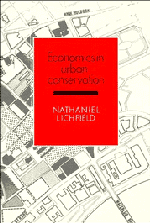Book contents
- Frontmatter
- Contents
- List of diagrams, tables and plans
- Preface
- Acknowledgements
- Introduction
- Part I Planning and management in the conservation of the urban system
- Part II Conservation of the cultural built heritage
- Part III Economics in urban conservation
- Part IV Selected tools of economic analysis for project evaluation
- Part V Case studies in the economics of conservation of the CBH
- Notes
- Bibliography
- Index
Part IV - Selected tools of economic analysis for project evaluation
Published online by Cambridge University Press: 10 November 2010
- Frontmatter
- Contents
- List of diagrams, tables and plans
- Preface
- Acknowledgements
- Introduction
- Part I Planning and management in the conservation of the urban system
- Part II Conservation of the cultural built heritage
- Part III Economics in urban conservation
- Part IV Selected tools of economic analysis for project evaluation
- Part V Case studies in the economics of conservation of the CBH
- Notes
- Bibliography
- Index
Summary
Introduction
In Part III we explored the role of economics in the conservation of the built environment and in particular the cultural built heritage. To advance that role we need to use the appropriate tools of economic analysis. As was seen, many are involved, such as forecasting and feasibility analysis. Within these there is one family of tools of particular relevance, namely project evaluation or appraisal. This is now introduced.
This family comprises a huge variety of tools, which are devised to answer a variety of questions. We need therefore to select those which are relevant to the issues raised in this study, namely those which aim to predict, estimate and value the costs and benefits and their distribution amongst the parties involved and affected in particular projects. As brought out in Part III, there are three in number, viz:
Financial and social financial analysis (FA and SFA).
Cost benefit and social cost benefit analysis (CBA and SCBA).
Community impact analysis (CIA).
These are considered respectively in detail in Chapters 13–15. As a preliminary we introduce here (a) some common features of the three and then (b) some differences.
Some common features
Our central concern is with any development project (including for renewal and conservation) which is an injection into the urban and regional system (1.1). By this injection the development project aims at using resources (inputs) to produce change (outputs) into that system. To evaluate/appraise the project we need accordingly to specify the inputs and the outputs.
- Type
- Chapter
- Information
- Economics in Urban Conservation , pp. 217 - 226Publisher: Cambridge University PressPrint publication year: 1989



